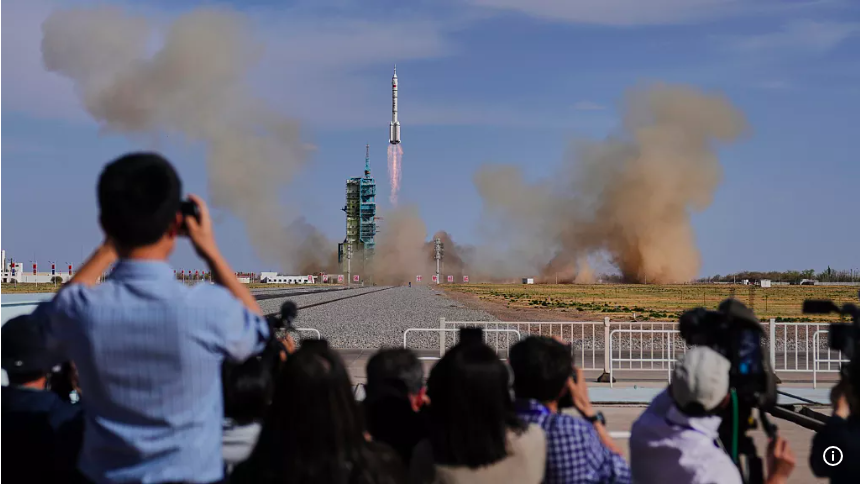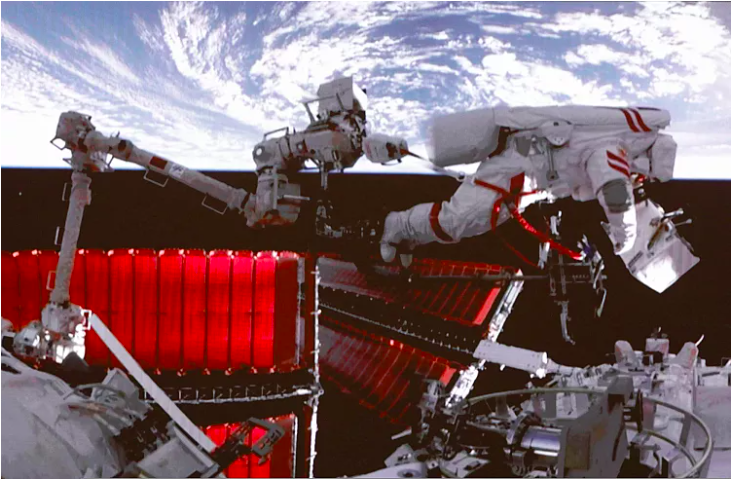China Launches Spacecraft Tianwen-2 Mission to Collect Asteroid Samples in Mars and Explore Deep Space
Quote from Alex bobby on May 30, 2025, 4:17 AM
China Launches Tianwen-2 in Bold Mission to Retrieve Asteroid Samples and Explore Deep Space
China has launched a bold new chapter in its rapidly advancing space program with the successful takeoff of the Tianwen-2 spacecraft, a mission that aims to collect samples from an asteroid near Mars and delve deeper into the solar system by exploring a distant comet. The mission, unveiled by the China National Space Administration (CNSA), promises not only to expand humanity’s understanding of the cosmos but also to cement China's growing reputation as a global space power.
Historic Launch and Ambitious Goals
Tianwen-2 lifted off early Thursday aboard a Long March 3-B rocket from a launch site in southern China. The probe’s primary target is asteroid 2016HO3, a quasi-satellite of Earth that orbits in a relatively stable path. The mission plans to land on the asteroid, collect surface samples, and return them to Earth within approximately two years.
Following that phase, Tianwen-2 will continue its ambitious journey to investigate comet 311P/PANSTARRS, located in the asteroid belt between Mars and Jupiter. The dual-target mission makes Tianwen-2 one of the most complex and forward-looking space explorations undertaken by any country to date.
According to Shan Zhongde, head of CNSA, Tianwen-2 “represents a significant step in China's new journey of interplanetary exploration” and over its decade-long mission is expected to “yield groundbreaking discoveries and expand humanity's knowledge of the cosmos.”
Why Asteroids?
Asteroids like 2016HO3 are believed to be some of the oldest and most primitive celestial bodies in the solar system. By studying them, scientists hope to gain vital clues about the formation of Earth, the origin of water, and perhaps even the raw materials that led to life itself. The chosen targets are particularly interesting due to their stable orbits, making them ideal for study and sample return missions.
The exploration of comet 311P will add another layer of scientific inquiry. This main-belt comet displays unusual activity, including periodic outgassing and fragmentation, offering a rare opportunity to study the evolution of small bodies in the solar system.
Building on Previous Successes
Tianwen-2 follows a series of increasingly ambitious Chinese space missions. In 2020, China became the first nation to return rock samples from the far side of the moon—a region that is notoriously hard to reach due to its rugged terrain and lack of direct communication with Earth. That mission marked a historic milestone in space exploration and showcased China’s growing technical capabilities.
China also became the third country to land a rover on Mars with its Tianwen-1 mission and now operates a fully domestically built space station, Tiangong (Heavenly Palace). This orbital laboratory currently houses a crew of three astronauts and is designed to host long-term experiments in microgravity—further asserting China’s independence in human spaceflight after being excluded from the US-led International Space Station (ISS) due to national security restrictions.
Open to Collaboration, But Barriers Remain
In a nod to international diplomacy, China has expressed willingness to collaborate with other countries on its space missions. However, any partnership with the United States remains complicated due to legislative restrictions, most notably the Wolf Amendment, which bans direct bilateral cooperation between NASA and Chinese entities.
Despite this, Chinese officials continue to emphasise the importance of global cooperation in space. “Scientific exploration knows no borders,” one CNSA official said in a statement, echoing the sentiment that the vast expanse of space should be a realm for shared discovery.
A Look to the Future
China’s space ambitions show no signs of slowing down. The CNSA has announced that Tianwen-4, a planned mission to explore Jupiter and its moons, is in the pipeline, though details remain scarce. Meanwhile, the country remains on track to land its first astronauts on the moon before 2030, a goal that will further challenge the dominance of long-established space powers like the United States and Russia.
With Tianwen-2, China not only reaffirms its place at the forefront of space exploration but also signals that it intends to remain there. By reaching beyond the moon to asteroids and comets, China is participating in the grand quest to answer some of the most fundamental questions about our origins and place in the universe.
Conclusion
The launch of Tianwen-2 marks a new frontier for China's interplanetary exploration program. By collecting samples from a near-Earth asteroid and investigating a distant comet, China aims to expand scientific knowledge in ways that could benefit all of humanity. As global interest in space heats up, China’s commitment to long-term, high-risk, high-reward missions like Tianwen-2 underscores its determination to become a leader in the next great space age. Whether operating alone or with future partners, China is undoubtedly charting a bold path into the final frontier.

China Launches Tianwen-2 in Bold Mission to Retrieve Asteroid Samples and Explore Deep Space
China has launched a bold new chapter in its rapidly advancing space program with the successful takeoff of the Tianwen-2 spacecraft, a mission that aims to collect samples from an asteroid near Mars and delve deeper into the solar system by exploring a distant comet. The mission, unveiled by the China National Space Administration (CNSA), promises not only to expand humanity’s understanding of the cosmos but also to cement China's growing reputation as a global space power.
Historic Launch and Ambitious Goals
Register for Tekedia Mini-MBA edition 17 (June 9 – Sept 6, 2025) today for early bird discounts. Do annual for access to Blucera.com.
Tekedia AI in Business Masterclass opens registrations.
Join Tekedia Capital Syndicate and co-invest in great global startups.
Register to become a better CEO or Director with Tekedia CEO & Director Program.
Tianwen-2 lifted off early Thursday aboard a Long March 3-B rocket from a launch site in southern China. The probe’s primary target is asteroid 2016HO3, a quasi-satellite of Earth that orbits in a relatively stable path. The mission plans to land on the asteroid, collect surface samples, and return them to Earth within approximately two years.
Following that phase, Tianwen-2 will continue its ambitious journey to investigate comet 311P/PANSTARRS, located in the asteroid belt between Mars and Jupiter. The dual-target mission makes Tianwen-2 one of the most complex and forward-looking space explorations undertaken by any country to date.
According to Shan Zhongde, head of CNSA, Tianwen-2 “represents a significant step in China's new journey of interplanetary exploration” and over its decade-long mission is expected to “yield groundbreaking discoveries and expand humanity's knowledge of the cosmos.”
Why Asteroids?
Asteroids like 2016HO3 are believed to be some of the oldest and most primitive celestial bodies in the solar system. By studying them, scientists hope to gain vital clues about the formation of Earth, the origin of water, and perhaps even the raw materials that led to life itself. The chosen targets are particularly interesting due to their stable orbits, making them ideal for study and sample return missions.
The exploration of comet 311P will add another layer of scientific inquiry. This main-belt comet displays unusual activity, including periodic outgassing and fragmentation, offering a rare opportunity to study the evolution of small bodies in the solar system.
Building on Previous Successes
Tianwen-2 follows a series of increasingly ambitious Chinese space missions. In 2020, China became the first nation to return rock samples from the far side of the moon—a region that is notoriously hard to reach due to its rugged terrain and lack of direct communication with Earth. That mission marked a historic milestone in space exploration and showcased China’s growing technical capabilities.

China also became the third country to land a rover on Mars with its Tianwen-1 mission and now operates a fully domestically built space station, Tiangong (Heavenly Palace). This orbital laboratory currently houses a crew of three astronauts and is designed to host long-term experiments in microgravity—further asserting China’s independence in human spaceflight after being excluded from the US-led International Space Station (ISS) due to national security restrictions.
Open to Collaboration, But Barriers Remain
In a nod to international diplomacy, China has expressed willingness to collaborate with other countries on its space missions. However, any partnership with the United States remains complicated due to legislative restrictions, most notably the Wolf Amendment, which bans direct bilateral cooperation between NASA and Chinese entities.
Despite this, Chinese officials continue to emphasise the importance of global cooperation in space. “Scientific exploration knows no borders,” one CNSA official said in a statement, echoing the sentiment that the vast expanse of space should be a realm for shared discovery.
A Look to the Future
China’s space ambitions show no signs of slowing down. The CNSA has announced that Tianwen-4, a planned mission to explore Jupiter and its moons, is in the pipeline, though details remain scarce. Meanwhile, the country remains on track to land its first astronauts on the moon before 2030, a goal that will further challenge the dominance of long-established space powers like the United States and Russia.
With Tianwen-2, China not only reaffirms its place at the forefront of space exploration but also signals that it intends to remain there. By reaching beyond the moon to asteroids and comets, China is participating in the grand quest to answer some of the most fundamental questions about our origins and place in the universe.
Conclusion
The launch of Tianwen-2 marks a new frontier for China's interplanetary exploration program. By collecting samples from a near-Earth asteroid and investigating a distant comet, China aims to expand scientific knowledge in ways that could benefit all of humanity. As global interest in space heats up, China’s commitment to long-term, high-risk, high-reward missions like Tianwen-2 underscores its determination to become a leader in the next great space age. Whether operating alone or with future partners, China is undoubtedly charting a bold path into the final frontier.
Uploaded files:


